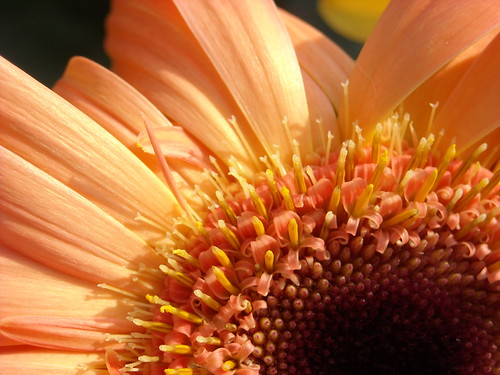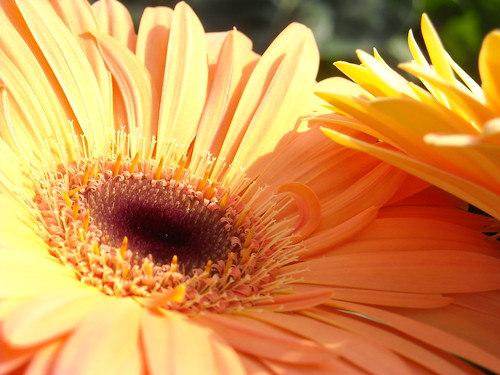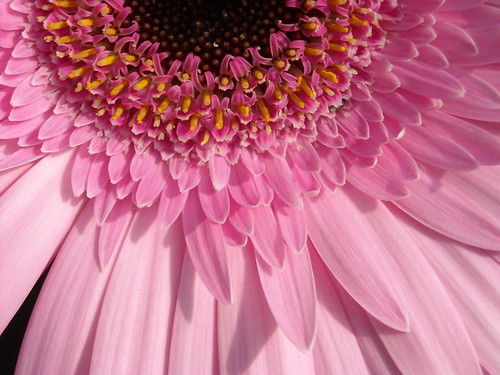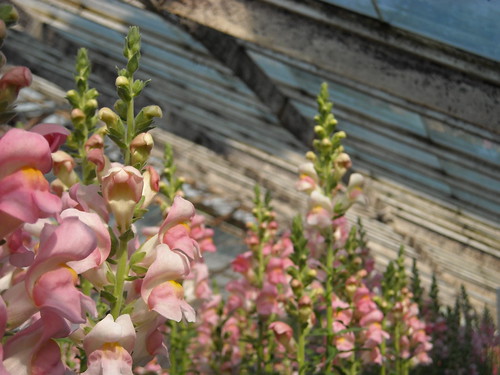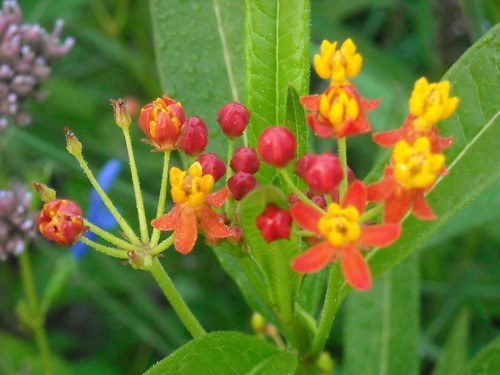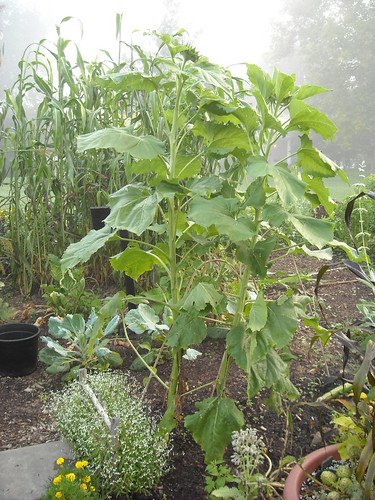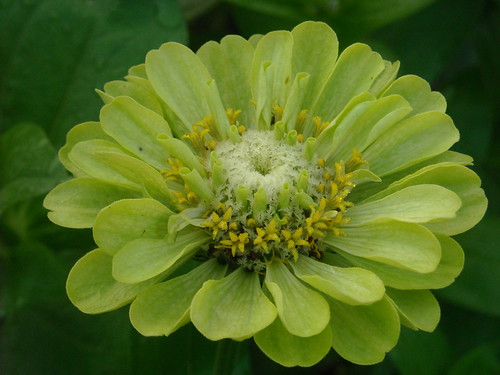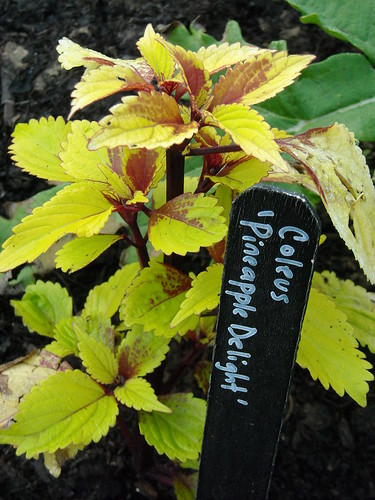
27 August 2009
21 August 2009
It's Alive!
So I'm here to tell you, my creation is alive! It's Alive! Alive, I say! Mwuahahahahahahahah!
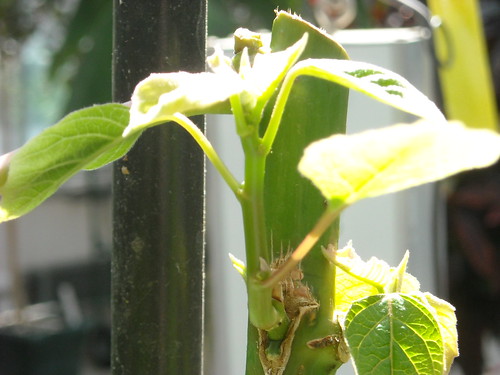 The Poinsettia bud I grafted onto a standard stem 'took'! I hadn't seen it since that fateful day when I ever so gingerly sliced and diced a bud from one species and slipped it into the stem of another, swaddled it in paraffin and entreated it to grow, dammit! Well, grow, dammit, it did!
The Poinsettia bud I grafted onto a standard stem 'took'! I hadn't seen it since that fateful day when I ever so gingerly sliced and diced a bud from one species and slipped it into the stem of another, swaddled it in paraffin and entreated it to grow, dammit! Well, grow, dammit, it did!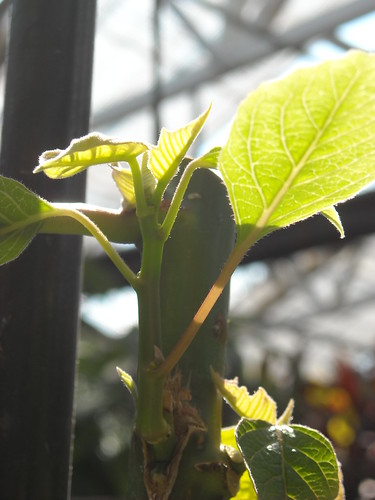 At some point in the proceedings the greenhouse grower decided it was a done deal, removed the paraffin wrap and now it's sending the bud shoot skyward along with a few fellows grafted by other hands. With the proper care and attention, the shoots will eventually fill in and the new creation - a giant Poinsettia standard destined for Longwood's Christmas display in the conservatory - will come to fruition. Too bad it'll take about 3 years and who knows where I'll be at that point or what sorts of horticultural mischief I'll be up to but at least I can go on knowing that I had a hand in creating something new, something magnificent, something that people from all over the world will one day see and marvel at (I'm telling you, these Poinsettia standards are nigh on six-feet across! If you don't believe me you'll just have to check back in December and read my Christmas display posts).
At some point in the proceedings the greenhouse grower decided it was a done deal, removed the paraffin wrap and now it's sending the bud shoot skyward along with a few fellows grafted by other hands. With the proper care and attention, the shoots will eventually fill in and the new creation - a giant Poinsettia standard destined for Longwood's Christmas display in the conservatory - will come to fruition. Too bad it'll take about 3 years and who knows where I'll be at that point or what sorts of horticultural mischief I'll be up to but at least I can go on knowing that I had a hand in creating something new, something magnificent, something that people from all over the world will one day see and marvel at (I'm telling you, these Poinsettia standards are nigh on six-feet across! If you don't believe me you'll just have to check back in December and read my Christmas display posts).My botanical legacy. Pretty darn cool!
Now all I need is a fiendish little lab assistant and my standing as evil plant scientist will be complete!
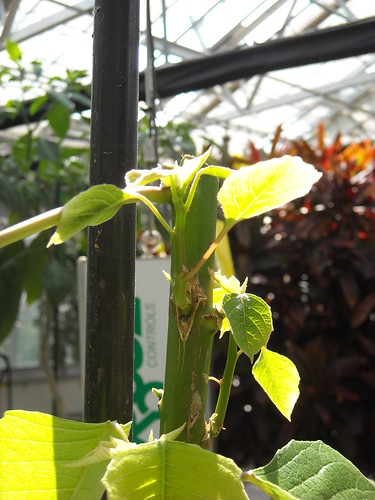
20 August 2009
Coffee. Garden. Coffee. Does a good morning need anything else?
My container garden needs a little fluffing up for fall; the patio tomatoes are done and their space needs to be filled so I threw in a couple of the Coleus that I propagated during my time in Greenhouse Production. Since I've got enough Pansies left over from my Greenhouse Management project I'll pop them in when they're big enough.
 I was kind of excited about the Millet...not only is the foliage flippin' gorgeous, the seed heads keep the birds happy!
I was kind of excited about the Millet...not only is the foliage flippin' gorgeous, the seed heads keep the birds happy!
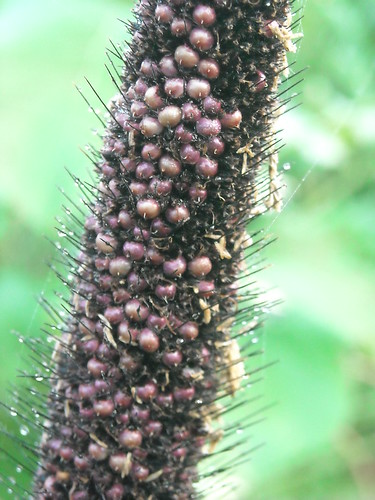 Probably my favorite part of the container is the Salvia discolor, which I grew in my garden in LA. Back there it would have started blooming in the spring and wouldn't stop. Here, it didn't start blooming until a few weeks ago. In LA, the Black Sage went from a 4" pot to a froth of bloom in a few months. Here, it's still a little spindly and not very full, so I'm eager to see how it overwinters and what it does its second year. Fun stuff, this gardening in another climate!
Probably my favorite part of the container is the Salvia discolor, which I grew in my garden in LA. Back there it would have started blooming in the spring and wouldn't stop. Here, it didn't start blooming until a few weeks ago. In LA, the Black Sage went from a 4" pot to a froth of bloom in a few months. Here, it's still a little spindly and not very full, so I'm eager to see how it overwinters and what it does its second year. Fun stuff, this gardening in another climate!
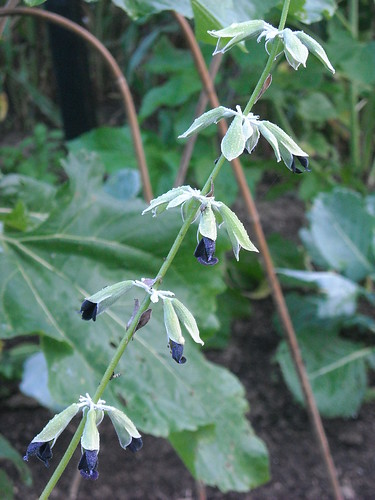
And then there's the Mina lobata...
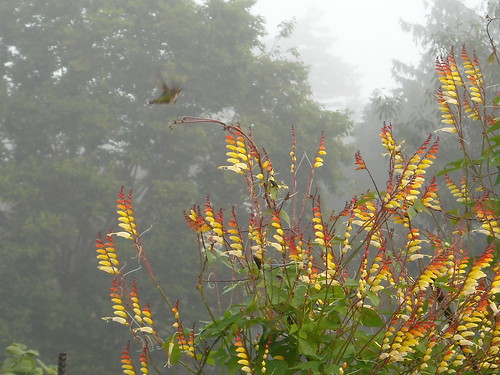
See the humming bird? No words needed. I watched the hummer as it flew off and saw this...
 The Broom Corn absolutely towers above everything else in the garden! To make it even more spectacular, the seed heads are starting to put on their fall colors. It's awesome!
The Broom Corn absolutely towers above everything else in the garden! To make it even more spectacular, the seed heads are starting to put on their fall colors. It's awesome!
Over in the northwest quad, the Mexican Hat was having a garden fiesta...
 And the Asclepias is in full flower, keeping the Monarchs and Swallowtails happy.
And the Asclepias is in full flower, keeping the Monarchs and Swallowtails happy.

One huge disappointment has been this Tanacetum. My garden in LA had two Tanacetums that I was rather fond of (T. haradjani which looks like a carpet of silver ostrich feathers, and T. 'Beth Chatto' named for the English plantswoman I had the honor of meeting a few years ago). Those Tanacetums thrived on the neglect I lavished upon them. They didn't mind the garden's sandy soil and minimal water, either. Enter the poor Tanacetum in my PA garden, where we've had one of the wettest summers in recent memory. Even though I exercised the same amount of neglect I gave their cousins in LA, the heavier - and wetter - soil here has resulted in a superbly tetchy plant! One of them gave it up altogether and another is thinking about it.

The giant sunflowers are finally starting to aspire to their reputed 12' height (no thanks to the deer nibbling them when they were babies) but they have no hope against the Broom Corn!
18 August 2009
One bee makes no swarm...
Imagine yourself spending an industrious afternoon mowing a vast expanse of lawn. It's not a bad job. After all, it's a ride-on mower! So there you are minding your own business, mowing away, when you turn a corner and see this:
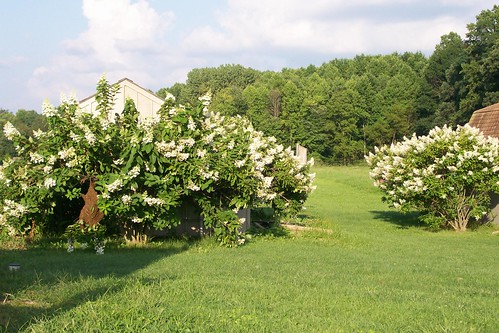 What lovely Hydrangeas, you say. But what's that dead branch there on the left? Being the conscientious Professional Gardener Student that you are, you decide to take a closer look...
What lovely Hydrangeas, you say. But what's that dead branch there on the left? Being the conscientious Professional Gardener Student that you are, you decide to take a closer look... If you were me, you might ask yourself, "What's that turkey doing hanging from the Hydrangea bush?" But you are not me and you know it's not a turkey or any other barnyard fowl, for that matter. You know without a shadow of a doubt it's a swarm of bees!
If you were me, you might ask yourself, "What's that turkey doing hanging from the Hydrangea bush?" But you are not me and you know it's not a turkey or any other barnyard fowl, for that matter. You know without a shadow of a doubt it's a swarm of bees!
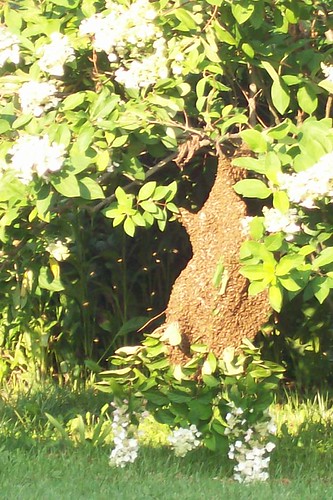

Here's what happened: the existing hive behind the student greenhouse had gotten a bit cramped for the bees already in residence. When this happens - sometimes a few times a season - the bees within rear a new queen and prepare to swarm. Those who are about to set off and establish a new hive drink as much honey as they can as fuel for the journey. When everyone's ready, they follow the new queen to her chosen destination and set to work building a new home.
In this case, the queen didn't go very far - only about 30-feet from the original hive. Luckily she went toward the student gardens to a shrub that was manageable as far as height. Had she gone toward the woods or into a taller tree, retrieving the swarm would have been much more difficult and dangerous.

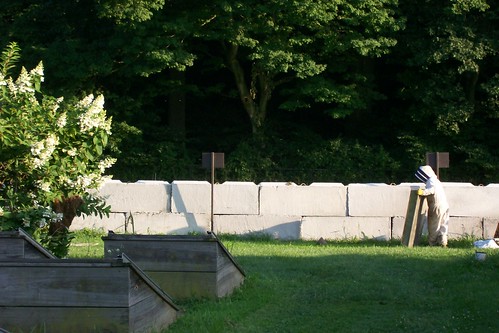
 Once the pallet and boxes were in place and level, Emma spread a sheet on the ground under the swarm. Now, keep in mind, we in the gallery were standing about 20-30' away. Far enough that the swarming bees took no interest in us but close enough that we could see hundreds - nay, thousands - of them forming a cloud around Emma as she worked, and none of it seemed to phase her. She moved with care but also seemed completely relaxed and confident in what she was about to do. I'm not sure the rest of us would have been so brave.
Once the pallet and boxes were in place and level, Emma spread a sheet on the ground under the swarm. Now, keep in mind, we in the gallery were standing about 20-30' away. Far enough that the swarming bees took no interest in us but close enough that we could see hundreds - nay, thousands - of them forming a cloud around Emma as she worked, and none of it seemed to phase her. She moved with care but also seemed completely relaxed and confident in what she was about to do. I'm not sure the rest of us would have been so brave.
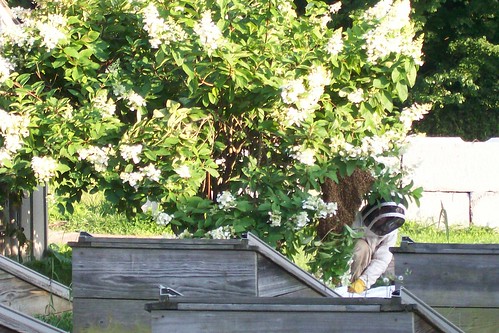 Once the sheet was spread below the swarm, the branch was lopped off and the whole thing fell onto the sheet. Needless to say, this made the bees a little agitated and the cloud around Emma thickened as they began to flurry around.
Once the sheet was spread below the swarm, the branch was lopped off and the whole thing fell onto the sheet. Needless to say, this made the bees a little agitated and the cloud around Emma thickened as they began to flurry around.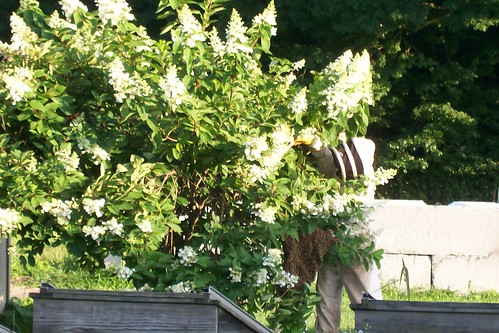 Folding up the four corners of the sheet to envelope the branch, she carried it over to the new hive.
Folding up the four corners of the sheet to envelope the branch, she carried it over to the new hive. 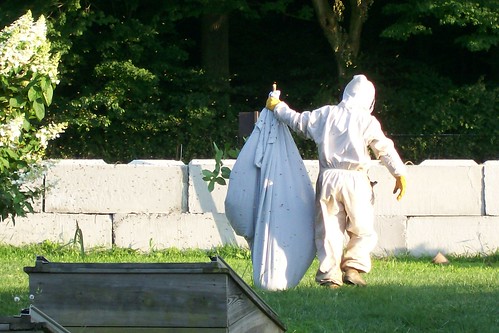
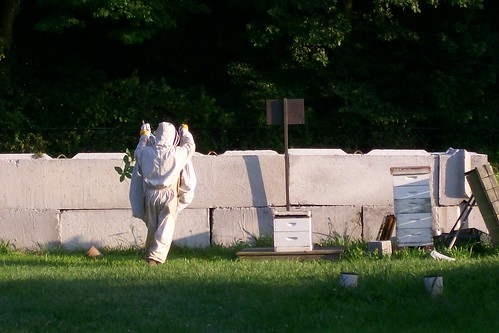 Laying the sheet and branch carefully at the hive opening.
Laying the sheet and branch carefully at the hive opening.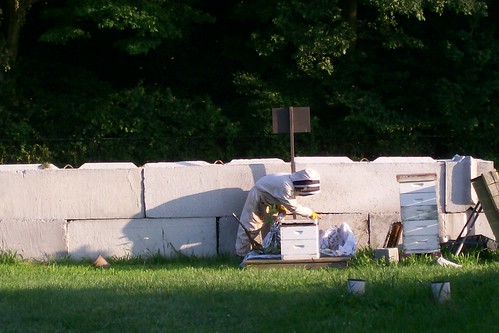
 Mission accomplished, Emma slowly walked away from the hive and let the bees get used to their new home. She very wisely used inserts (the part the bees make the combs and honey on) from the original hive, so the swarm actually smelled their own pheromones and honey and immediately began marching into the new hive!
Mission accomplished, Emma slowly walked away from the hive and let the bees get used to their new home. She very wisely used inserts (the part the bees make the combs and honey on) from the original hive, so the swarm actually smelled their own pheromones and honey and immediately began marching into the new hive! Now, the bees that were swarming were still hot on the trail of the queen bee's scent so the cloud followed Emma and her bundle but others continued to swarm onto the cut branch in the Hydrangea. What to do about them?
Now, the bees that were swarming were still hot on the trail of the queen bee's scent so the cloud followed Emma and her bundle but others continued to swarm onto the cut branch in the Hydrangea. What to do about them? 
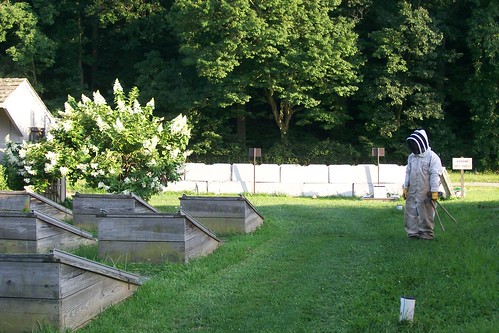 The smaller swarm was cut and taken to join their comrades at the hive. Here it is up close, and you can see the bees entering the box.
The smaller swarm was cut and taken to join their comrades at the hive. Here it is up close, and you can see the bees entering the box.
 This was one of those spectacles that you simply had to witness first hand to appreciate. If our adrenaline was pumping - and it was - I can't imagine what was coursing through Emma's veins! In the end, the swarm adopted their new home and now, thanks to Emma's courage and heroism, there are two active hives here on the Row.
This was one of those spectacles that you simply had to witness first hand to appreciate. If our adrenaline was pumping - and it was - I can't imagine what was coursing through Emma's veins! In the end, the swarm adopted their new home and now, thanks to Emma's courage and heroism, there are two active hives here on the Row.Saint John Chrisostum once said, "The bee is more honored than other animals, not because she labors, but because she labors for others". Today I give honor to Emma, who labored for others - not just the bees, but in consideration of the safety of those who live on the Row. Kerry-Ann proclaimed that Emma is the bravest person she's ever known and I have to say I agree.
Bravo, Emma! You're awesome!
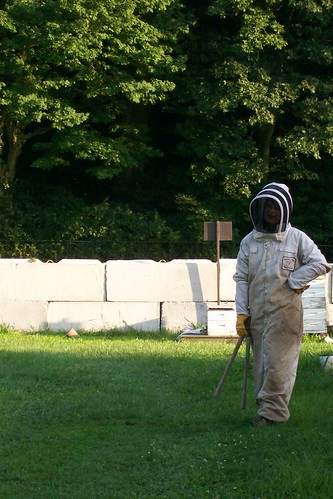
09 August 2009
Let my words, like vegetables, be tender and sweet, for tomorrow I may have to eat them
 Here it is nestled in a box of onions, also from my garden. While these were grown from transplants started by the Senior PG's, I still had the pleasure of planting them and watching them grow throughout the summer.
Here it is nestled in a box of onions, also from my garden. While these were grown from transplants started by the Senior PG's, I still had the pleasure of planting them and watching them grow throughout the summer.



.JPG) Another plant I grew from seed and had high hopes for was Swiss Chard 'Bright Lights'. It was supposed to be a colorful foil in what was turning out to be a very monochromatic veggie garden. Just as it was putting on color, the dreaded deer devoured it.
Another plant I grew from seed and had high hopes for was Swiss Chard 'Bright Lights'. It was supposed to be a colorful foil in what was turning out to be a very monochromatic veggie garden. Just as it was putting on color, the dreaded deer devoured it.  I yanked the remaining shreds out the other day and made a mental note that next year I would erect battlements with embrasures and and arrow-loops in the merlons for our deer hunting friends. Maybe even a flying parapet with machiolations! A woman's garden is her castle, after all.
I yanked the remaining shreds out the other day and made a mental note that next year I would erect battlements with embrasures and and arrow-loops in the merlons for our deer hunting friends. Maybe even a flying parapet with machiolations! A woman's garden is her castle, after all.Unfortunately, no amount of crenellation will defend the garden against unseen invaders like blight. Our tomato crops have been decimated by late blight and Phytophthora. The Phytophthora - a water-mold that lives in the soil and is spread in cool, wet weather, kinda like what we've been experiencing (she types confidently, as the rain comes down in sheets outside) - was responsible for the Great Irish Potato Famine in the 1800's and now is tainting our tomatoes. Everyone on the Row who had tomatoes in their garden yanked them out and piled them up on the bonfire. I managed to get one 'Yellow Ruffles' tomato; all the others were goners. And now, let us observe a moment of silence for our friend the tomato...
 I haven't yet decided what will go in its place, but we have ornamental gourd seedlings that need a home. The one reason I hesitate with the gourds is due to the on-going challenges with my Zucchini. Last week I ripped out all but two plants that were infested with the evil Squash Vine Borer. Sometimes their murderous mastication only affects one stem but lately they've succeeded in taking down entire plants. So while this plant had a hole in the side shoot, the rest of the main stem was still healthy and pumping out zucchini like a machine.
I haven't yet decided what will go in its place, but we have ornamental gourd seedlings that need a home. The one reason I hesitate with the gourds is due to the on-going challenges with my Zucchini. Last week I ripped out all but two plants that were infested with the evil Squash Vine Borer. Sometimes their murderous mastication only affects one stem but lately they've succeeded in taking down entire plants. So while this plant had a hole in the side shoot, the rest of the main stem was still healthy and pumping out zucchini like a machine.  He was immediately dispatched. There are chemicals that take care of these pests but I'm not yet licensed in the state of PA to apply them and anyway, I want to keep my garden as organic as possible which is why row covers are on my shopping list for next year to keep the little moth from laying eggs on my plants in the first place.
He was immediately dispatched. There are chemicals that take care of these pests but I'm not yet licensed in the state of PA to apply them and anyway, I want to keep my garden as organic as possible which is why row covers are on my shopping list for next year to keep the little moth from laying eggs on my plants in the first place.Speaking of Lepidoptera, that favorite of insect orders, our class in Entomology has illuminated my way of thinking and I now realize there are both good guys and bad guys in this order. This is one of the good guys, Papilio polyxenes, otherwise known as an Eastern Black Swallowtail. He's nibbling happily on my Italian Parsley, which shows what good taste they have. I don't mind the damage they do which is interesting considering both species are eating my crops. So why do I harbor such hatred for one and tolerance for the other? Possibly because one does nothing but leave a trail of destruction in its wake while the other nibbles for a bit then transforms itself into a beautiful pollinator? We gardeners can be so prejudiced, can't we?
+-+Copy.JPG) While the rain continues to fall outside I think I'll spend the morning planning next year's garden - more of this, less of that, a new variety of something else (RED sweet corn! "Really red, really sweet", the seed catalog said! I can't wait!). I also need to check the yellow pages for castle builders...a portcullis at the garden gate would be perfect!
While the rain continues to fall outside I think I'll spend the morning planning next year's garden - more of this, less of that, a new variety of something else (RED sweet corn! "Really red, really sweet", the seed catalog said! I can't wait!). I also need to check the yellow pages for castle builders...a portcullis at the garden gate would be perfect!

